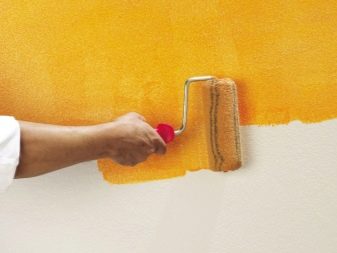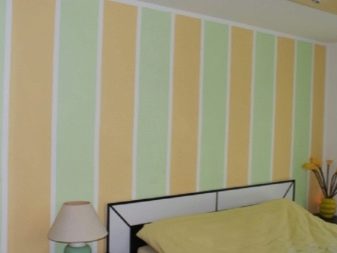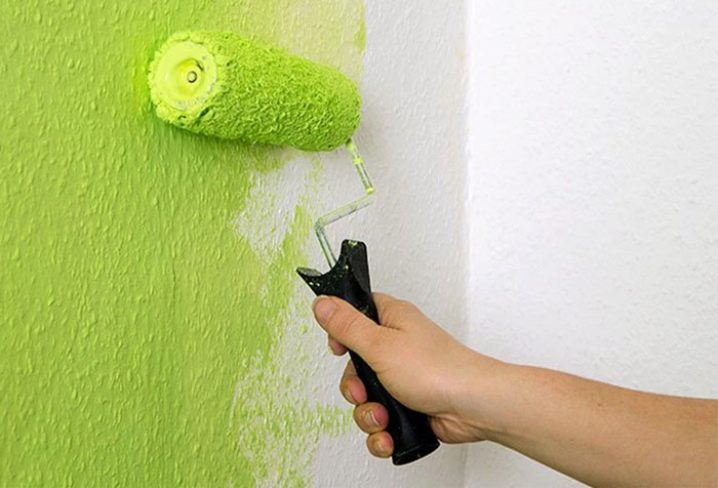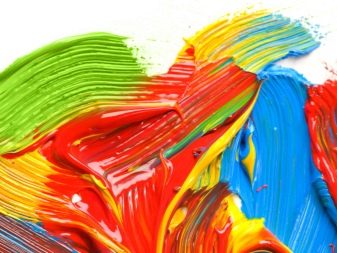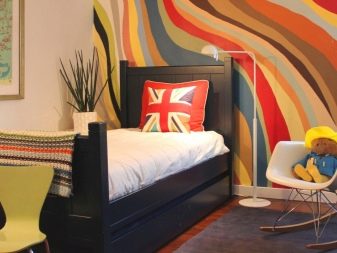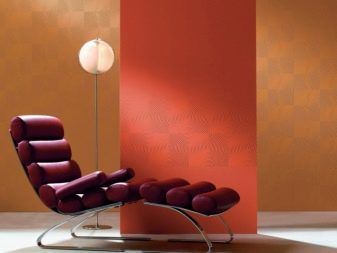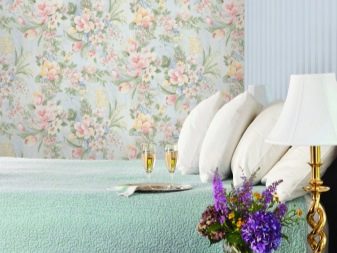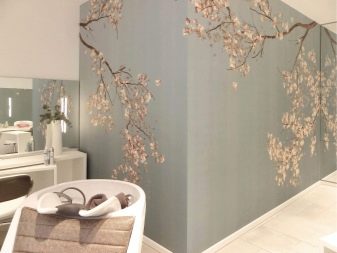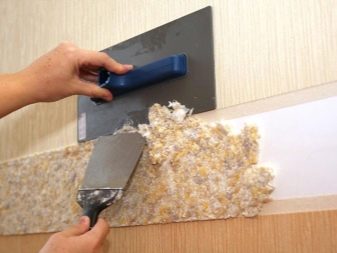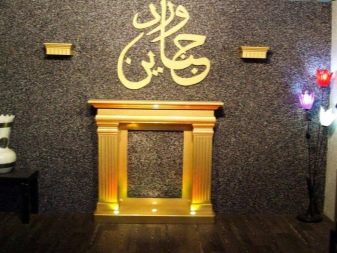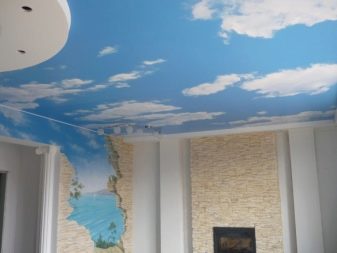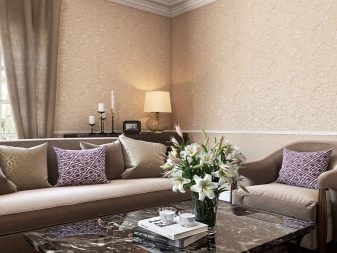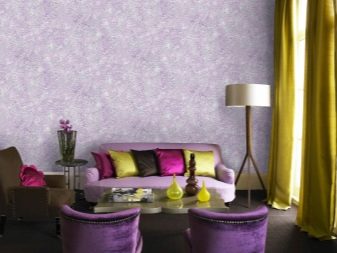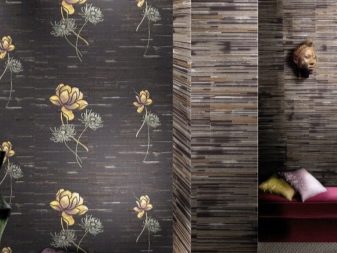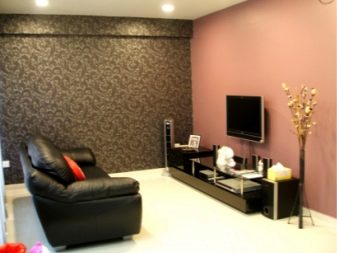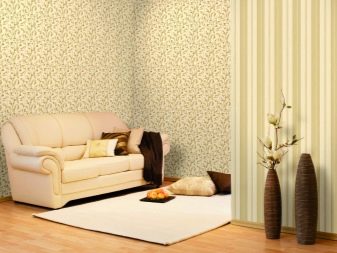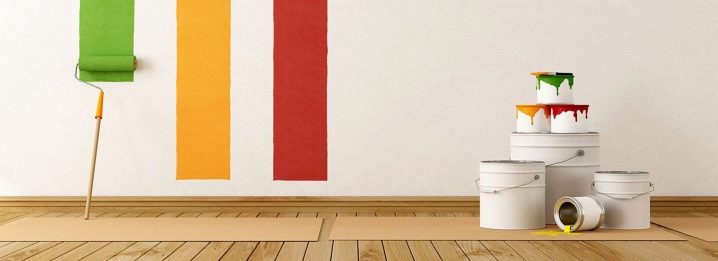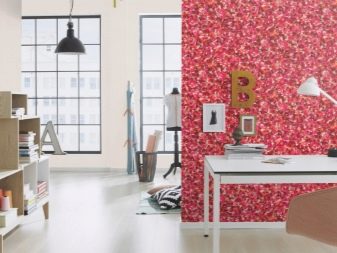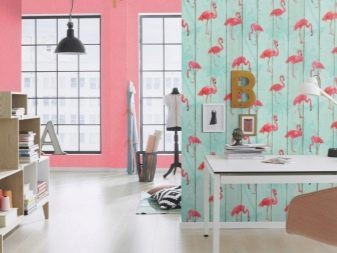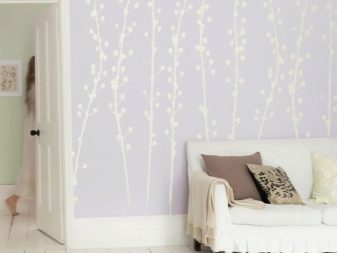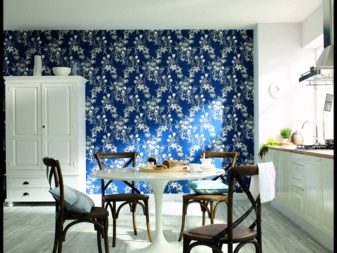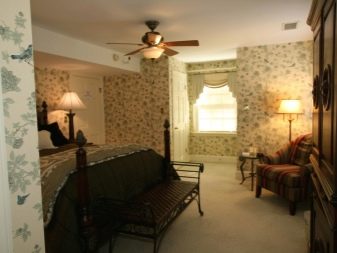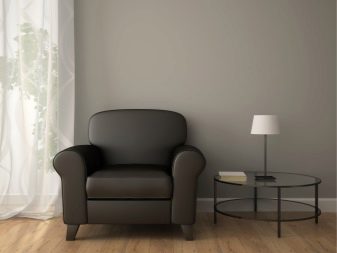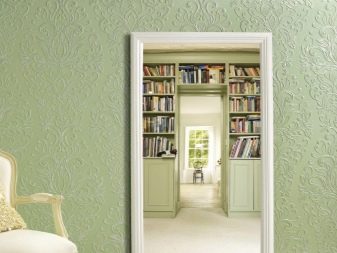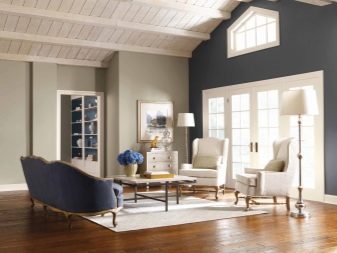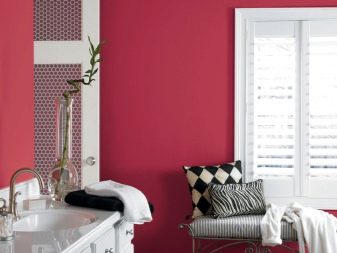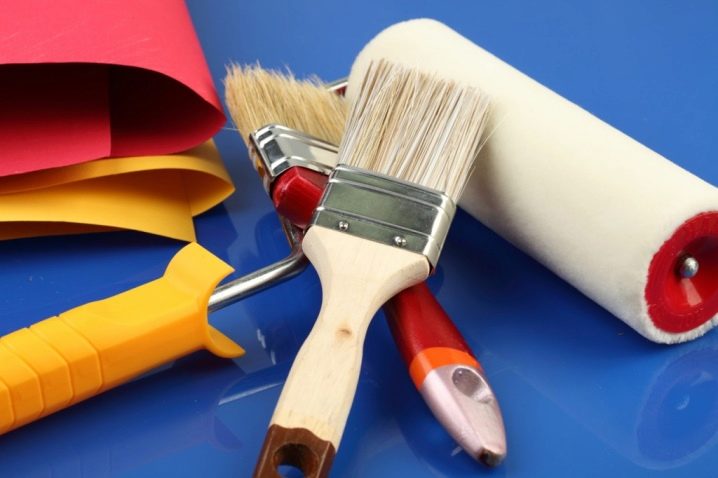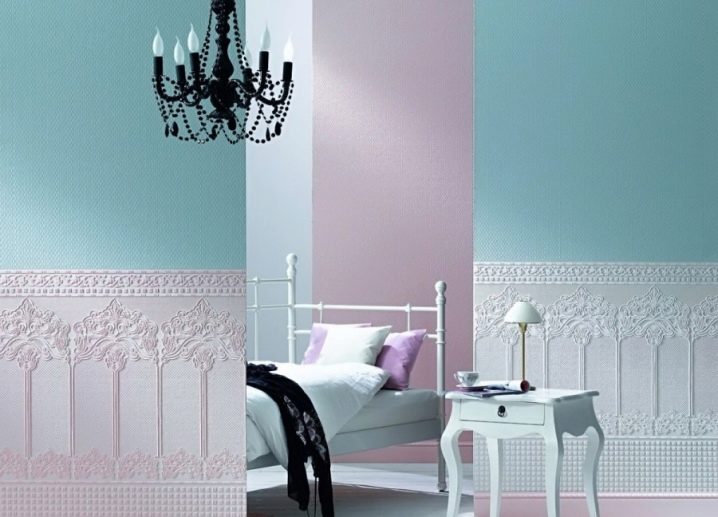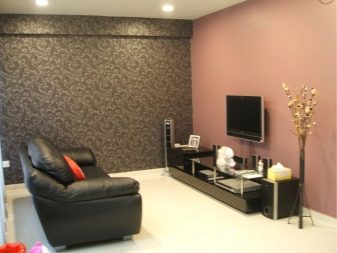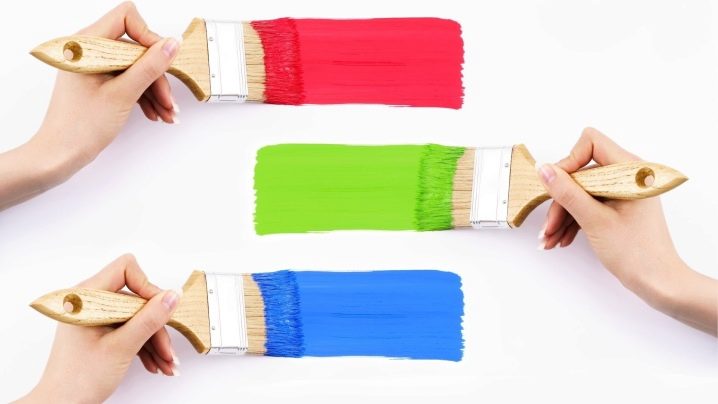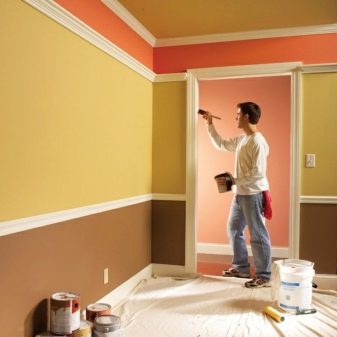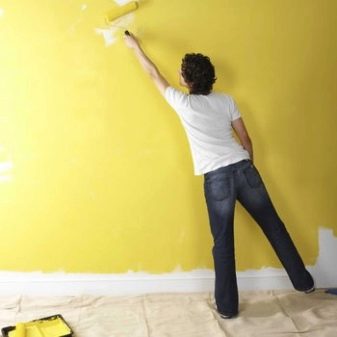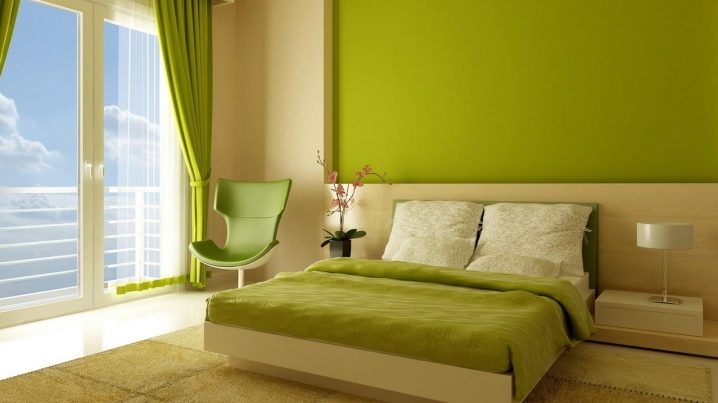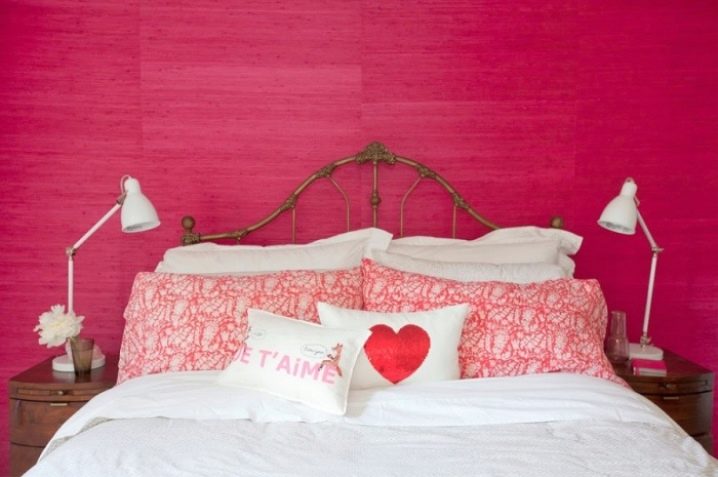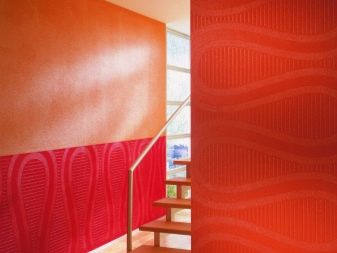Choosing paint for wallpaper for painting
Wallpaper for painting - quite a frequent and convenient solution for those who make their own repairs, or for those who like to often change the surrounding space. The most difficult thing in this event is not the choice of a specific brand of wallpaper and their sticking, but the choice of paint, which can be any color, matte or glossy, for different types of bases, and so on.
Kinds
There are many different types of coloring matter that are suitable for use on top of wallpaper for painting. They will differ in several parameters, such as price, terms of use, consumption, as well as other characteristics.
One of the most common options is water-based varieties of paints.This kind of coloring matter is safe for the environment and is suitable for use in a residential area. Of the other advantages - the surface painted with such paint, easy to clean: it can be cleaned with a damp cloth and washed, while it has absolutely no odor. It dries very quickly: just one day is enough for the painted surface to dry.
Minus water-based paints - the need for careful preparation of the surface to paint. If it is not well primed beforehand, the liquid will simply be absorbed into the porous surface, and you will get not a beautifully painted wall, but ugly stains or the absence of any traces of painting.
Acrylic paint for wallpaper for painting is also a frequent choice for repair. As a rule, it is bought for non-woven wallpaper, but sometimes it is rational to use it on paper or glass fiber wallpaper. Water-based acrylic paint is an excellent solution for those who want to get rich and bright wall color. It is very pleasant that over time it will not fade and will last for many years. The paint is waterproof, with a faint odor and very quick-drying.
Another waterproof paint - latex, forming a thin, but very durable layer on the painted surface. It is made on the basis of a water-dispersion paint, to which are added individual polymers and acrylic. The layer of such a product will be so strong that if you want to remove it then it will be extremely difficult to do: so if you are looking for lasting beauty to cover the wallpaper, this option is for you. This paint has a very low consumption, reasonable price, and it is very easy to apply to the surface in any way.
Paint-plaster or decorative plaster combines the advantages of two materials at the same time. It will allow you to simultaneously paint over the desired area, align it and give a beautiful view thanks to the resulting pattern.
What is the color different basics?
The final paint selection depends on the type of substrate. Depending on what the walls for painting are pasted over, the required material will differ. The right choice is a guarantee that the repair will not have to be redone, and the result will be pleasing to the eye.
For paper wallpaper, water-based paint is best. It is easy to apply, it comes out with a thin layer that will be enough: paper wallpapers should not be soaked with paint, because there is a high risk of their breaking.This type of wallpaper is usually the cheapest, as a result of which their quality is often not very high, but it is these wallpapers that are most often used for interior work.
To paint non-woven wallpaper, you must purchase water-dispersion or latex paint. Such wallpaper is dense, as a rule, embossed, and easily carry up to 15 repaints.
If you have vinyl wallpaper, then do not rush to throw away their packaging: the manufacturer indicated the type of paint required. Paint such wallpaper should be in two layers: first, a primer is covered over the wall, and then paint is applied directly. The second layer should not be strong - it is impossible to let the liquid soak deep into the material.
Popular and liquid wallpaper. The technology "weeping wallpaper" is simple: the dry mixture is diluted with water, and then immediately applied to the surface. After they were used and put on the wall, they no longer have to be repainted: they are initially colored. For a more even color, you can paint the wall before they are applied. Pearl decorative paint is suitable for liquid wallpaper, which has already dried: so emphasize their relief.
Until now, one of the frequent ways of giving a pretty look to the ceiling in rooms is the use of ceiling wallpapers. Wallpapers for painting on the ceiling are the same as for walls, and in order to choose the type of necessary coloring matter, it is necessary to start from the same principles as when painting walls.
Color spectrum
All the palette of colors and shades available to the human eye is represented in modern stores. Paints can be sold as ready-made, with a certain shade, and those that need to be kneaded by yourself. That is, you are offered a white base and a set of colors - liquids that need to be mixed with the base to get the desired color, for example, a beige color, loved by many in the interior, when mixed with white, yellow and orange. Without experience, it can be difficult to make a necessary shade at once, and it is also desirable to mix the paint once and in one container for a uniform color over the entire painted surface.
This option will be very interesting to look in the children's room, however, adults will also like this choice.
The resulting effect also differs: the surface after the application of the solution can be either glossy or matte, or with a pearl effect or even with sparkles.You can choose a white background, and color paint will be a bright accent on your wall. An interesting solution will be silver or gold hues, the main thing is not to overdo it.
If you want something unusual, choose graphite color. As a rule, it is applied in order to create an opportunity to write and draw with chalk on the surface.
Brand Rating
The choice of paints and their manufacturers present in our market is very wide. It is difficult to unequivocally argue that some of them are better than all the others: as a rule, each brand specializes in its type of paint.
Many of the variations found on the market are made in Europe: for example, Dufa, Superweiss or Wandfarbe are famous German brands, Polish paint with the gentle name Sniezka or English Johnstone “s can also be seen on the shelves and in online stores.
One of the most famous European brands familiar to most is the Tikkurila brand from Finland. Tikkurila opened its production in Russia in 1995. The company's products are presented in all price categories, and their silicate water-based paint becomes the sales leader.
Beckers paint is produced in neighboring Swedenwhich is universal and suitable for painting all types of surfaces and has long been used even in the most severe conditions. Like most European paints, it is certified and meets recognized environmental standards.
Another English trademark, Dulux, belonging to the AkzoNobel concern, supplies paint in 26 countries of the world. Brand products are water resistant, so it is often purchased for repairs in kitchens and bathrooms. Another plus is the resistance to staining, so it is recommended to use in rooms with high humidity.
Russian brands in hardware stores are also very recognizable. Buyers are often recommended to paint such brands as “Neva Paints”, “Yaroslavl Paints” or “Admiral”. Products called "Eurolux" or Empils, oddly enough, also produced in Russia and has a good quality.
The Turkish brand Marshall manufactures products with a very low consumption per square meter, which is able to withstand not only wiping with a damp cloth, but also cleaning with chemicals. If you make repairs where there are children who like to paint on the walls - buy the paint of this brand and do not be afraid that along with the children's drawings the paint will leave the wall as well.
Paint from another continent Parkerpaint offers an extensive range of colors. The American company guarantees ease of application, high quality of the resulting coating and long life.
Another American brand Shwerin-Williams produces coloring compositions, the quality of which you can not worry about when buying. They are produced in a sealed package, so you can expect a long service life from them, especially after a long transport from production to the store.
We consider consumption
The consumption of paint used can be very different in each case.
It depends on several indicators:
- the type of wallpaper used for the repair;
- paint manufacturer;
- number of layers.
In order not to buy too much paint, you must first prepare and measure the area for painting. After that, all openings are measured: door, window and other, provided by your project or imagination. The area of the openings is subtracted from the total area: these will be the parameters you need.
As a rule, each manufacturer indicates on the packaging of his product an approximate paint consumption per 1 m2.However, you can calculate it yourself: if you are going to paint the wall in one layer, then the consumption will be approximately 150-180 g / m2 of paint, if two - then 250 g / m2 and more. Note that when staining in two layers, each individual layer should be thinner than when stained in one layer.
Also, the consumption depends on the type of surface, as each type of wallpaper for painting has its own type of absorbency. For example, vinyl wallpaper will save you money, since they are distinguished by the least absorption: no more than one liter of paint per 10 m2. If you purchased a wallpaper with a rough surface, such as glass fiber, paint consumption will also decrease - pay attention to it.
In any case, in order not to be mistaken, buy paint with a margin, then you will be sure that you will not have to run to the store and hope that the color you need is still on sale.
Necessary tools
In order to qualitatively paint the walls, you may need an unexpectedly large number of tools. Of course, you can do basic - it is a roller and a brush. It is with them that you will apply the paint directly to the surface.
Rollers can be either foam or fur.The first option is most common, as it is used to paint smooth surfaces. Fur roller is suitable if you want to make a textured finish.
Brushes are also different, they differ in the material from which the pile or bristle is made, in size (width), purpose. To brush was guaranteed to be good and did not spoil your process, you need to hold your hand over the pile and check that the hairs from which it is made will not crawl out.
Other useful tools include the following:
- masking tape to avoid those situations when the paint gets out beyond the necessary boundaries, spoiling furniture, door jambs and other things. Masking tape will be simply necessary if you paint the surface in several colors, and also it can replace stencils for you;
- the stencil roller will allow you to apply the drawing on the plain walls. If you try, you can make it yourself, thereby obtaining a unique pattern on the walls of your room;
- the paint cuvette is a container with a corrugated bottom for squeezing out excess paint on the roller. In addition, the use of such a tool will allow the roller to be impregnated evenly;
- construction mixer for mixing paint. Necessary when using old paint or paint with the addition of color to obtain a uniform color throughout the tank. If not, you can use a long wand, but the process in this case will slow down at times;
- To speed up the painting process, you can use an airbrush - a tool that allows you to apply paint on a large surface in a very thin layer in a short period of time.
In addition to the above mentioned tools, it is extremely important to use personal protective equipment:
- gloves, both textile and rubber, which are best worn in two layers;
- respirator;
- working clothes;
- headband;
- protective glasses.
How long does it dry?
Each type of paint is characterized by its rate of drying on the surface. It depends on the composition, on the environment - it is wet indoors or, on the contrary, damp, and other external conditions.
Among other factors affecting the drying rate, the following can be identified:
- The thickness of the applied layer. The thicker the paint coat, the longer the surface will dry;
- The temperature in the room or on the street. On the packaging, manufacturers, as a rule, print the required temperature mode of operation.So, for example, at too high temperatures, the paint may become more liquid, and not dry, respectively, the curing time will increase;
- Porosity of the surface to be coated. Hit is higher, and the more paint required for a single-colored paint, the greater the amount of time required for complete drying;
- Ventilation. We can not allow drafts, the result will only get worse, and the coating will crack, but a competent built ventilation system and an active air flow will help speed up the drying process.
Among all types of coloring materials, the longest drying type is oil paints. Previously, they could dry for several days, but in modern times pentaphthalic or alkyd bases were added to their composition, which made it possible to shorten the drying period to one day.
Nitro and enamel paints dry many times faster: the second layer on top of the first can be applied immediately after half an hour after dyeing, and complete drying occurs no more than 12 hours.
Water emulsion solutions reach the primary polymerization in a couple of hours, and completely dry out in approximately 16-24 hours, but there are also some species that will be completely dry after 12 hours.
If you use paint in cans or spray gun, you can be happy.
This method of painting can save drying time, since the resulting layer is much thinner than with manual application, respectively, the drying time is reduced several times.
Which is better?
To choose the right paint in your case, you must take into account all the conditions in which you have to work. If you make a mistake with the choice, then the appearance of the room where the repair will be made will become unpresentable. In the worst case, you will have to remove the worn out wallpaper and re-glue them, and then re-paint the walls.
The following factors must be considered for the correct choice of material:
- Type of wallpaper. Remember that, for example, paper and non-woven wallpapers require different types of paint;
- The format of the room. A children's room, a corridor or a bathroom are various operating conditions that should be taken into account in order for the coating to last a long time;
- The desired appearance of the surface. It can be smooth, and maybe with a pattern - so, and the paint will be different;
- Possible paint consumption. Compositions with low consumption, perhaps, will cost more, but for painting large areas is a plus that will save.
Based on these factors, you can safely choose for yourself the desired type of paint and bring the room in which the repair is done, in an attractive condition.
On what kind of paint is better to choose for painting wallpaper, see the following video:
What to paint again?
If you decide to paint the walls again, first make sure that the old paint does not move away from the wall and is holding tight. Then the surface must be sanded, getting rid of the remnants of the coating, clinging uncertainly to the surface and risking to spoil the result, primed and immediately painted in one or more layers.
In the case of repainting the walls it is completely unimportant what the wall was painted for the first time. If acrylic paint was originally applied to the surface, you can not be afraid to repaint it with a water-based paint: it will still appear.
The nuance that should be taken into account: if you are going to repaint a wall from a dark color into a light color, first paint it in a neutral color and then in the required light color.This will reduce the risk of dark spots, and the process will be easier.
Beautiful interiors
To decide on the final color of the walls and ceiling in the room, you can look at the photos of the finished interiors.
The classic solution - a juicy insert on the wall diversifies the look of the room.
The combination of bright walls and light furniture and decorative elements is a bold decision that will appeal to extraordinary people.
The combination of several bright colors or one bright, and another more muted will allow you to highlight certain areas in the room.
Neutral colors will always remain in fashion and are ideal for followers of classic styles.
In addition, the use of wallpaper for painting gives just for imagination: any pattern or picture on the wall is in your hands.
Well, if you decide to make textured walls, then textured paint is the easiest, fastest and cheapest way to achieve a beautiful surface.

